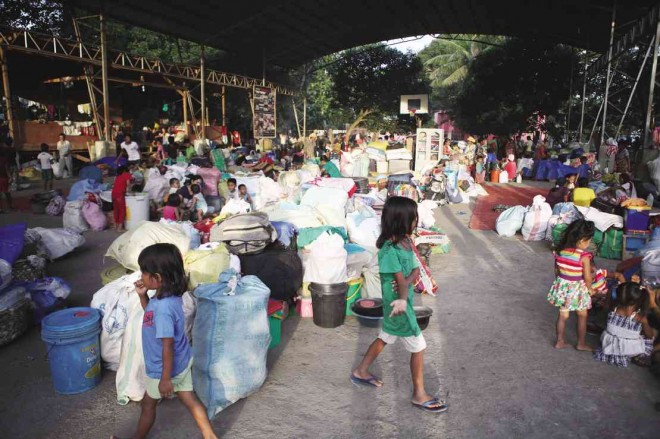
RESIDENTS seek refuge in a gymnasium in Pagalungan town in Maguindanao province on Feb. 17. The gun battle between two rival Moro rebel groups in the boundary of Maguindanao and North Cotabato has displaced more than 20,000 individuals. JEOFFREY MAITEM / INQUIRER MINDANAO
DAVAO CITY — Hungry, tired, thirsty and oftentimes unable to sleep, children at the evacuation sites in Maguindanao wish for the war to stop so that they can go home and live normal lives again, according to the report of a humanitarian mission led by the groups Kawagib and Suara Bangsamoro.
The report, released on Friday, said 152 children, aged one to 13 years old, who joined the group’s psychosocial activities in barangays (villages) Dapiawan and Madia of Datu Saudi Ampatuan town, already wanted to go home, go back to school and live normal lives again.
“These children are living with their parents at the congested evacuation centers,” said the report of the humanitarian mission, which entered some barangays of Datu Saudi and Shariff Aguak towns on March 10 to 13.
“Some of them are suffering from chicken pox, rashes, coughs, colds and fever. Diarrhea is also common due to unsafe drinking water at the evacuation centers,” the report added.
“We might be able to escape the bullets, but hunger and fear might slowly kill us,” the mission report cited what 9-year old Raissa told them. The mission’s psychosocial team said even adults at the evacuation sites were already suffering symptoms of severe depressions, anxieties and trauma.
In sitio Kulneto in Barangay Timbangan in Shariff Aguak town, the mission’s medical team warned against the onset of bacterial and viral diseases if the prevailing shortage of food, lack of safe drinking water and congestion—continues for another week.
Amid the sound of mortar shelling, Dr. Hasmine B. Macaraya-Sumandar and Dr. Sittie Aysha Iba of the Cotabato Regional Medical Center (CRMC), the report said, served a total of 163 patients, majority of them children during their more than three hours stay in sitio Kulneto.
A total of 125, or majority of the 165 patients served, suffer from upper respiratory tract infection (URTI) because of the poor shelters, where they were unprotected from heat, dust and the odor of animal feces during daytime; and against cold wind at night.
Trauma and stress were also evident in all of the patients, the report said.
The mission said there was a marked absence of local health stations in all the evacuation centers they visited, including Sitio Kulneto.
The group said local health agencies should increase the frequency of their visits to the evacuation sites to serve affected evacuees, who badly needed help. They should also roam around to reach out to home-based evacuees, instead of limiting themselves to displaced persons at the evacuation sites.
The mission report also said the all-out war, supposedly waged by the government against the BIFF, has transformed into an “attack on civilian communities,” as the number of affected civilians swelled to over 93,000 and still growing.
Quoting barangay officials, the mission report said the way the government forces fire mortars and drop bombs indiscriminately make them think they were the actual targets of the attacks instead of the BIFF.
Civilians also questioned the use of artillery towards civilian communities when there is no verified presence of the BIFF.
“The military offensive has practically transformed the civilian communities into a war zone,” the report said, citing how the Second Mechanized Battalion encamped within the vicinity of the evacuation center and the barangay hall in barangay Madia and how the Marine Landing Battalion (MBLT) Team 8 of the Philippine Marines installed 81 millimeter mortars on March 11 in the area, directed at an unspecified target.
“This is a direct example of militarizing the area and using it as a launching pad for attacking other communities,” the report said.
The mission also called for a stop to the all-out war and all-out offensive against the Bangsamoro people, an immediate pull out of military troops from civilian communities and a stop to the harassment of Moro civilians.
In Cotabato City, the Autonomous Region in Muslim Mindanao government will embark on a campaign aimed gathering at least one million signatures for peace.
Lawyer Rasol Mitmug, Gov. Mujiv Hataman’s chief of staff, said the signature campaign was to be launched during the commemoration of the March 18 Jabidah massacre.
The campaign will run for three months, he said.
Mitmug said it signifies the people’s struggle to attain a lasting peace and end the armed conflicts in Mindanao.
“We have to spread this aspiration to Luzon and the Visayas, that Mindanao has had enough of hostilities and armed confrontation; and it’s about time to unite in the name of peace and end the sufferings of our people,” Mitmug said.
“There is no better option, but for a non-violent struggle to advance the Bangsamoro aspiration for peace and prosperity,” Hataman said.
He said the price of war was difficult to bear, citing the situation in Maguindanao.
“This week alone, the number of evacuees have swelled from 64,000 to nearly a hundred thousand, and from 11 affected municipalities two more towns – Datu Hoffer and Datu Odin Sinsuat have to attend to some 1,000 displaced individuals, based from latest figures relayed by the Department of Social Services and Development with the collaboration of local government units,” he said.
ARMM Executive Secretary Laisa Alamia said the situation was also depleting the region’s humanitarian fund that they were now soliciting contribution for the displaced residents.
RELATED STORIES
Gov’t forces have become ‘terrorists,’ says militant Bangsamoro group
MJ Lastimosa says no to ‘all-out war’ in Mindanao